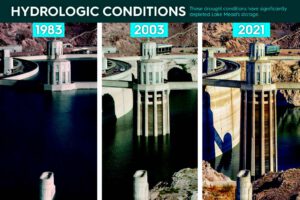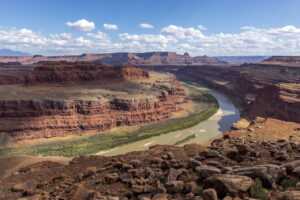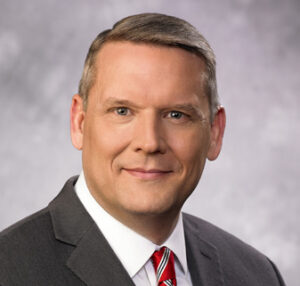As general manager of the Southern Nevada Water Authority (SNWA), John Entsminger leads the agency responsible for acquiring and distributing the Las Vegas region’s share of Colorado River water. In 2014, he was appointed by Governor Sandoval to serve as Nevada’s lead negotiator on Colorado River matters, and he played a key role in developing interbasin and international agreements to protect Lake Mead water elevations. In this interview, Municipal Water Leader contributing editor Jeff Kightlinger speaks with Mr. Entsminger about negotiations over sharing a dwindling resource—and what it will take to “make this river work for everybody.”
Jeff Kightlinger: Much has happened on the Colorado River since Municipal Water Leader last spoke with you in 2019. As droughts have gotten worse, the Drought Contingency Plan (DCP) has been implemented. What has changed over the last 3 years?
John Entsminger: In the first half of 2019, one of the biggest concerns was that the hydrology might be so good that we would lose the momentum to get the deal done. That was followed by bad water years in 2020 and 2021, which I believe were the driest back-to-back years in recorded history, eclipsing 2012 and 2013. That’s caused a rapid decrease in the elevations of both Lake Powell and Lake Mead, and over the last 6 months or so, the lower basin has come to the table to try to add another layer of protection to the reservoirs in the form of the 500+ Plan.

Jeff Kightlinger: Please tell us about the DCP and how it led to the 500+ Plan.
John Entsminger: The protections we have put in place, just for the lower basin, are the shortage volumes that we agreed to as part of the 2007 guidelines, when we started seeing the modeling and realizing that shortages of 333,000 acre-feet, 420,000 acre-feet, and 500,000 acre-feet—which come into force at the elevations of 1,075 feet, 1,050 feet, and 1,025 feet, respectively—might be insufficient to protect critical elevations. One provision of the DCP, which we negotiated from 2015 to 2019, stated that if one of our 24‑month studies projected that Lake Mead elevations would drop between 1,030 feet during any month, we would come back to the table and try to negotiate additional measures to protect the elevation of 1,025 feet. I don’t know whether to say this is ironic or serendipitous, but the August 2021 study that formally triggered the first-ever shortage declaration under the 2007 guidelines also projected the possibility of Lake Mead going below 1,030 feet within the next 24 months, thereby triggering the consultation provision that led to the negotiation of the 500+ Plan.
Jeff Kightlinger: Please discuss the 500+ Plan.
John Entsminger: If you’re going to try to put additional protections in place, everybody has to agree what you’re measuring against. The June 2021 24‑month study made certain assumptions about how much water would be delivered, how much intentionally created surplus (ICS) would be created, and how much ICS would be delivered. We’re going to measure against that baseline, and during calendar years 2022 and 2023, we’re going to try to leave 500,000 acre-feet over that baseline in Lake Mead —hence the name 500+ Plan. For example, the Metropolitan Water District of Southern California was projected to take 123,000 acre-feet of ICS in 2023, but it made the commitment to take less, so the amount it has agreed not to take out of the lake accrues toward that goal of 500+. The plan also includes additional ICS creation and system conservation, so it’s a combination of people agreeing to leave water in the reservoir and becoming more efficient with what they do take.

Jeff Kightlinger: When the DCP was developed, negotiators were looking back at the 2007 guidelines and trying to return to certain previously assessed levels of risk. Was the 500+ Plan developed with a similar goal of returning to a specific level of risk of severe shortage?
John Entsminger: When we did the modeling for the 2007 guideline negotiations, there was a 4 percent chance of falling below a certain target elevation—I think either 1,025 or 1,000 feet—between 2007 and 2026. When we came together to negotiate the DCP, that risk had gone from 4 percent to more than 20–25 percent. That increased risk is what led us to negotiate those additional protection volumes. You’re exactly right: With the horrible hydrology that we saw in 2020 and early in 2021, that risk profile changed again, and both the Central Arizona Project (CAP) and SNWA did independent modeling of the volumes that would need to be conserved to protect those critical elevations. That was the genesis of the 500,000‑acre-foot quantity that the 500+ Plan is built around.
Jeff Kightlinger: The 2007 guidelines, the DCP, and the 500+ Plan all expire in 2026, so there’s quite a bit of work that must happen between now and 2026. How do you see that process developing?
John Entsminger: In addition to those three agreements, Minute 323, the Colorado River water-sharing agreement between the United States and Mexico, will also come to an end at the same time. There is a lot of work that needs to be done. At some point, the Biden administration is going to need to start the National Environmental Policy Act (NEPA) process for analyzing river operations in a post‑2026 scenario. If the basin states do not negotiate and agree to operating criteria for a post‑2026 world and analyze them under NEPA and the Endangered Species Act, then under the 2007 guidelines, we simply revert to long-range operating criteria. That does away with shortage agreements and introduces a lot of uncertainty into the system. It wouldn’t allow for the future creation of ICS, although there are some trailing provisions that would allow access to ICS that had already been created. It would put in place rigid operating restrictions at Lake Powell and Lake Mead. So the stakes are high. As you know, there will need to be negotiations among the upper and lower basin states. Ultimately, the seven states will need to come together. That group then needs to figure out how to work with our partners in Mexico and how to address the legitimate concerns of 29 Native American tribes and a lot of high-profile national nongovernmental organizations (NGOs). It’s a big tent that everybody has to be able to fit into, and we need to figure out how we’re going to make it work.
Jeff Kightlinger: What do you think you need from the federal government to achieve success by 2026?

John Entsminger: Fortunately, I think we have a once-in-a-generation infusion of cash. In my career, I’ve never seen the Bureau of Reclamation running around with $8–$9 billion, which it has right now. But more than anything, we’re going to need leaders. We need the U.S. Department of the Interior to set the agenda for what we’re going to accomplish and on what time frame. Left to our own devices, that big tent of people will take whatever amount of time we’re allowed to negotiate. Historically, we’ve done a lot of 5‑year negotiations to come up with 5‑year agreements, and even then, they only get signed when we are threatened by Interior. Does the Biden administration want to get to a record of decision by the end of its term in office? Does it want to get to a point at which it has the alternatives drafted but hasn’t selected a preferred alternative? Will it leave it to the next administration to get the deal across the finish line? Those fundamental decisions need to be made and clearly conveyed to all the stakeholders so that we can get to work.
Jeff Kightlinger: Discussions about the Colorado River have long included tribes and NGOs, including environmental groups. Now, those discussions seem to have gained intensity and attracted a lot more interest from broader stakeholder groups. Do you see this round of negotiations potentially being different in that way?
John Entsminger: I think there are a lot more groups that are more sophisticated; have more experience; and frankly, are bringing more resources to the table. Two guys with a laptop who only bring opinions to the table are not going to be as valuable as some of these big environmental groups that not only have monetary resources but the legislative skills to help you push things across the finish line in Congress. They’re the ones with deep relationships with Mexico. When people ask me, “How are you going to work with all these different groups?” my question is, “What are they bringing to the table?” It’s a free country, and under the NEPA process, anybody and everybody can make their opinions known. But if the only thing you’re bringing to the table is your opinion, it’s not going to be the most useful thing to help us get to the finish line.
Jeff Kightlinger: The distinction between partners and stakeholders is important, and it makes a lot of sense on the river. Speaking of partners, SNWA recently entered a partnership collaboration with Metropolitan on a regional recycled program. Tell us about your hopes for that program.
John Entsminger: First, I want to talk about the partnership between us at SNWA and Metropolitan, because I think it’s been the most important partnership SNWA has on the river. It goes back to our water-banking arrangements. There have been times in the past when the State Water Project was down and we had extra water that we were able to lend. We worked together on the Drop 2 Reservoir and on the Yuma Desalting Plant’s pilot run, and we were municipal investors under Minute 319 and Minute 323. We were founding members of the system conservation efforts that have saved water in all seven states.
The regional recycling project is a $3–$4 billion project to capture and reuse all the wastewater in Southern California. The overall idea is to make more water available in Southern California. My board has already voted to appropriate an additional $750 million for major capital projects to be a funder of that. I think it’s a poster child for the types of partnerships and investments that need to be made in the southwestern United States in the face of climate change and diminishing water supplies.
Jeff Kightlinger: Do you think that is the kind of project that is going to be needed to come up with a successful agreement by 2026 on how to deal with upcoming shortages on the river?
John Entsminger: Yes, absolutely. I think that if the water users across the basin remain in their own silos and just hope for the best—as we’ve seen on the Klamath and in the Central Valley of California, where the federal government has acted unilaterally—eventually, there will be no option left but for the federal government to pick winners and losers. If we want any sort of voice and control over our own destinies, we must forge these partnerships. We have to do unpopular things like raising water rates so that we have the financial resources to make these sorts of investments and continue to have some control over our own future.
Jeff Kightlinger: Climate change really seems to be in the driver’s seat these days, particularly on the Colorado River. What do you think we’re going to have to do to really make the river sustainable as part of these 2026 discussions?
John Entsminger: Though this may apply more broadly, I’ll use SNWA as a microcosm. Our board approved a new resource plan in December 2021. We had been using the figure of 12.9 million acre-feet of average annual flow as our climate change projection in our previous years’ resource plans. We changed that to 11 million acre-feet a year for 2021 resource planning. That may seem aggressive to some, but when you think about it, in 9 of the last 22 years, we have had less than 11 million acre-feet of inflow on the river. Frankly, we’re hopeful that 11 million is the worst-case scenario. If we were to have 11‑million-acre-foot inflows over the next 50 years, the elevations of Lake Mead would bounce around between 900 and 950 feet. Our resource plans include other scenarios that are rosier than that, but it’s important to include a worst-case climate change projection. In a scenario like that, to preserve economic diversification and a robust economy in southern Nevada, we project that we would need to drive our gallons per capita per day down from the current level of 112 to 86. That is a long way of saying that I believe the future of this river requires every person in every sector to figure out a way to use less water. That doesn’t necessarily mean less agriculture. SNWA is partnering on with CAP, the Central Utah Water Conservancy District, and Denver Water to look at how we can grow alfalfa with drip irrigation. It’s not necessarily a question of not having economic growth or not producing the amount of food we need; it’s figuring out how to do those things using less water.
Jeff Kightlinger: In the 1960s and 1970s, Arizona and California went to the Supreme Court and had a lot of battles and litigation on the river. Starting around 2000, we saw much more cooperation. In the future, do you think you’re going to see more collaboration among the states, or will it be a zero-sum game in which people are going to start bringing out their lawyers?
John Entsminger: I’m hopeful. I think the people who are at the negotiating table realize that you can negotiate for decades and not add another gallon of water to the river. Litigation isn’t going to substantively change the situation. I am a true believer in the cooperative process. We’ve seen Minute 319 between the United States and Mexico work. I have a copy in my office that’s translated into Russian because the Colorado River has been used as a model for national and international cooperation. I believe that collaboration is far and away the best course of action for the river going forward. It will be extremely difficult, but if people of goodwill can come together, I still believe we can make this river work for everybody.
John Entsminger is the general manager of the Southern Nevada Water Authority. He can be contacted at 1001 S. Valley View Boulevard, Las Vegas, Nevada, 89153.

